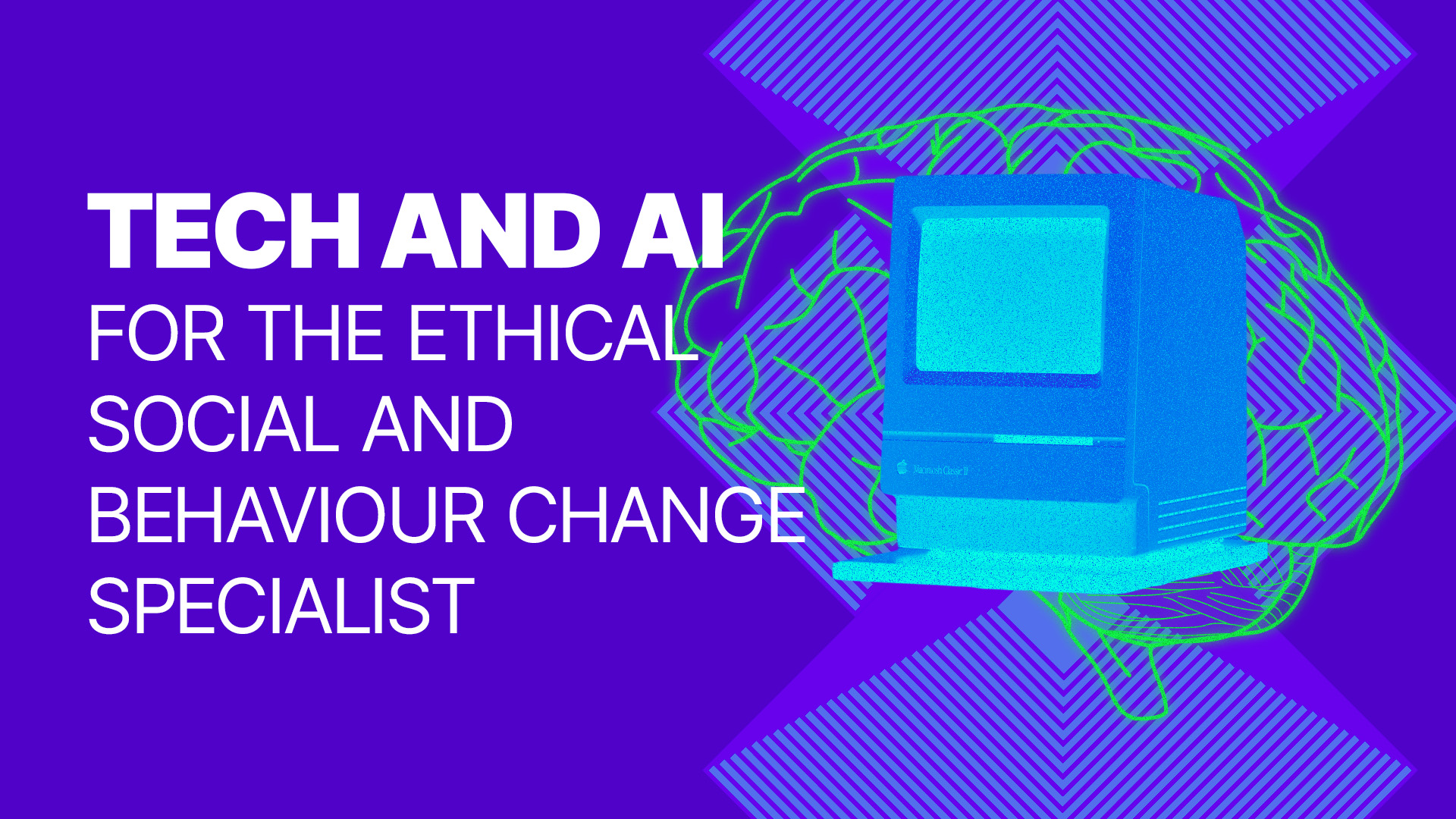This blog provides an introduction to Artificial Intelligence for social and behavior change specialists in the International Development and humanitarian sectors.
The ‘too long, didn’t read’ version
- AI hype is intense, though tech hype is nothing new
- The rate of change in AI technologies is accelerating
- AI = the ability of a machine to display human-like capabilities such as reasoning, learning, planning, and creativity
- AI presents opportunities for social and behavior change specialists in three areas:
- 1) improved personal workflows
- 2) improved organizational operations
- 3) improved programs
- The use of AI within operations and programs will likely require larger-scale technological support from engineers, designers, data scientists, and researchers
- Yes, there are risks and ethical concerns. Explore these to protect yourself and the people that you support
- Think of AI as a sub-set of technology to explore
- Start by committing to an interest in technology. Read books, take courses, seek external support, and create space for research and development
- This article includes several resources to assist you
Where can I start?
AI hype is intense at the moment. Much of this is due to recent releases of various versions of the natural language processing tool, ChatGPT. ChatGPT is the fastest-growing app in history.
AI has been part of our lives for years. And it has been a scientific field of study for decades.
Here are examples of AI in action:
- Email spam filters
- Autocorrect
- Personalised social media newsfeeds
- Spotify and Netflix content recommendations
- Google search results based on your personal search history
- Maps, navigation, and traffic predictions
- Customer service chatbots
You probably engage with several of those examples every day.
So why so much about AI hype now? That may depend on your outlook on life. Some reasons might include:
- Economic boom: “Let’s get ready for 10 trillion new dollars”
- Economic hardship: “We will soon be replaced by robots”
- Wary scientists: “Even AI experts are sounding the alarm”
- Tech barons: “Tech companies are building hype to boost stock value”
- Media: “Media representatives are stirring our emotions yet again”
- Utopia: “AI is different. It will save us all”
- Doomsday: “AI is different. It will end us all”
Tech hype is nothing new. Think of the last few years: Blockchain. Cryptocurrency. The Metaverse, 3D printing, autonomous vehicles, and virtual reality.
Each of these technologies holds meaningful exploration in the coming years. But have they lived up to the hype so far? Maybe not yet.
Other technologies, meanwhile, have indeed changed our existence. The internet. The mobile phone, the computer, the car, trains, and artificial light.
AI may be emerging as part of that second group.
What counts as artificial intelligence?
Definitions of AI change over time. Goalposts shift. But here are some definitions to consider:
- “It is the science and engineering of making intelligent machines, especially intelligent computer programs.” – John McCarthy, Computer Science Department, Stanford University
- “AI simply means software used by computers to mimic aspects of human intelligence.” – NewScientist
- “AI is the ability of a machine to display human-like capabilities such as reasoning, learning, planning, and creativity.” – European Parliament
- “(AI) is a field of study and type of technology characterized by the development and use of machines that are capable of performing tasks that usually would have required human intelligence.” – World Economic Forum
AI is about prediction
Some argue that AI’s power lies in prediction, and that prediction is the basis for human intelligence.
“Today, AI tools predict the intention of speech (Amazon’s Echo), predict command context (Apple’s Siri), predict what you want to buy (Amazon’s recommendations), predict which links will connect you to the information you want to find (Google search), predict when to apply the brakes to avoid danger (Tesla’s Autopilot), and predict the news you will want to read (Facebook’s newsfeed). None of these AI tools are performing an entire workflow. Instead, each delivers a predictive component to make it easier for someone to make a decision.” – Prediction Machines: The Simple Economics of Artificial Intelligence, Ajay Agrawal, Joshua Gans, and Avi Goldfarb
Tell me about risks and concerns
Technology like AI is a tool, and tools can come with risks.
For you, the social behavior change specialist, consider the following:
“[Deploying] humanitarian AI presents several challenges. Some of these, such as the risks of data bias, threats to privacy, and poor interpretability of models, are common to all high-stakes domains, from medicine to social services. Others, such as the lack of accountability and the danger of reinforcing old power dynamics between international and local actors pose a unique threat.” – Local communities should be part of designing humanitarian AI, World Economic Forum, 2022
The following examples might also hit close to home:
- Amnesty International was criticized for using AI-generated images
- Facial recognition taken to court in India’s surveillance hotspot
- Nonhuman humanitarianism: when ‘AI for good’ can be harmful
Why the fear?
Some critics say AI is already damaging society. They say we do not need to wait for ‘sentient’ artificial intelligence and humanized robots.
Instead, we can look at simpler, current technologies such as social media prediction engines. These have already enabled extremist thinking, filter bubbles, depression among children, and the proliferation of conspiracy theories.
“To get just an inkling of the fire we’re playing with, consider how content-selection algorithms function on social media. They aren’t particularly intelligent, but they are in a position to affect the entire world because they directly influence billions of people. Typically, such algorithms are designed to maximize click-through, that is, the probability that the user clicks on presented items. The solution is simply to present items that the user likes to click on, right? Wrong. The solution is to change the user’s preferences so that they become more predictable. A more predictable user can be fed items that they are likely to click on, thereby generating more revenue.” – Human Compatible: AI and the problem of control, Stuart Russell
Below are key concerns for anyone building or using AI tools to consider:
- Filter bubbles (isolation that occurs from personalized searches)
- Propaganda
- Data biases
- Data marginalization
- Hallucinations (unanticipated AI results, which may often seem authentic)
- Copyright issues and infringement
- Misinformation
- Misrepresentation and stereotyping of people, communities, and cultures
There are also wider concerns about the use of AI. For teams that wish to use or build AI technologies, particularly within organizations in the positive impact space, consider:
- Jobs displacement: AI could replace the equivalent of 300 million jobs – report
- Energy consumption: Measuring the environmental impacts of artificial intelligence computing and applications
- Environmental impact: AI and climate change: The mixed impact of machine learning
- AI colonialism: Artificial intelligence is creating a new colonial world order
- Techno solutionism: Harnessing the potential of artificial intelligence for humanitarian action: Opportunities and risks
How to use these technologies consciously?
Adopt a conscious, research-based approach to technology’s role in three areas:
- Improve personal workflows
- Improve operations
- Improve programs
How can tech improve my workflows?
For your workflows, you may already use tools to assist you with meeting transcriptions, brainstorming, and automation of repetitive tasks.
Below are recommendations for how tools like AI can improve workflows for social and behavior change specialists.
- Transcriptions: Saving time in the documentation of meetings with transcription tools
- Brainstorming: Fast research
- Content improvement assistants: AI tools to recommend improvements to content such as campaign emails
- Chatbots and personalized messaging: Use of chatbots and personalized messaging to speed up processes such as community engagement and also your engagement with personal donors
- AI-supported analytics tools: Use of AI-supported analytics tools to monitor web and social media performance
How can tech assist my operations?
For your organization’s operations, consider how technology such as AI may assist you to:
- Streamline fundraising
- Improve monitoring and evaluation
- Onboard staff and volunteers
- Collaborate within and between teams
- Improve employee engagement
- Automate workflows
How can tech assist my programs?
For your programs, consider how technology can help your organization to make an impact in some of the following areas:
- Communicate with communities at a greater scale
- Gather and learn from data that relates to sectors such as education, migration, health, and refugee data
- Amplify campaign content
- Improve data collection, reporting, monitoring, and evaluation
Below are examples of AI in international development and humanitarian scenarios:
- HungerMap LIVE by World Food Programme: Leverages big data and predictive analytics to track and predict food security in near real-time
- Foresight by Danish Refugee Council: A machine learning model developed to predict forced displacement (IDPs, refugees, and asylum seekers) at the national level 1-3 years into the future
- Magic Box by UNICEF: Uses real-time data generated by the private sector to gain critical insights into the needs of vulnerable populations, and make informed decisions about how to respond to disasters, epidemics, and other challenges
- Global Fishing Watch: Uses machine learning algorithms to analyze satellite images to monitor global fishing activity
Where can ethical social behavior change specialists start?
Take an interest in technology. Analyze its potential value and its potential risks. Find reliable material on tech use within your sector, and explore other organisations’ approaches.
Below are possible mindsets to adopt:
- Deep interest in technology and its potential for good
- Use an ethical approach
- Conscious study of potential risks and harms
- Exploration of other organizations’ adoption of technology
7 steps to conscious AI use for the ethical social and behavior change specialist
Below is a checklist of 7 specific actions that your team can undertake:
- Develop a data strategy for your organization
- Seek data, AI, and analytics literacy and training for technical staff
- Encourage culture development training for senior managers
- Explore investments in AI, including hardware, software, and services
- Create use cases for technology on operations and projects
- Create space for technology discussions so your team can stay in front of the industry
- Share your results, and showcase successes
A database of AI for Positive Impact programs
Our team, with the support of volunteers, is producing a database of positive impact programs that incorporate AI into core operations. Can you help us expand it? Contribute your ideas.
Resources to bring you up to speed fast
- Artificial Intelligence Index Report 2023, Stanford Institute for Human-Centered Artificial Intelligence (HAI)
- Harnessing the potential of artificial intelligence for humanitarian action: Opportunities and risks, International Review of the Red Cross
- Elements of AI free online course, University of Helsinki
- Human Compatible: AI and the problem of control, Stuart Russell
- Prediction Machines: The Simple Economics of Artificial Intelligence, Ajay Agrawal, Joshua Gans, and Avi Goldfarb

